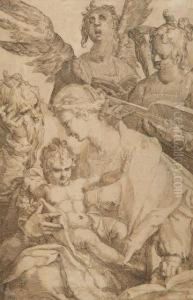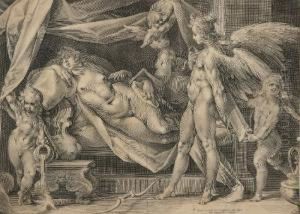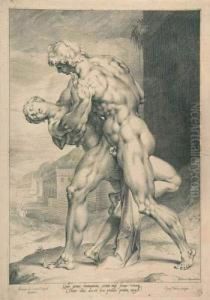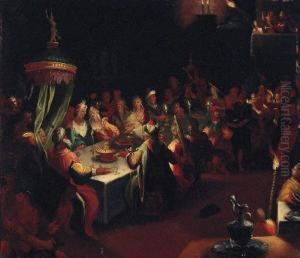Jan Harmensz. Muller Paintings
Jan Harmensz. Muller was a Dutch artist, born in 1571 in Amsterdam. He was the son of the engraver and publisher Harmen Jansz Muller and was trained by his father in the art of engraving. Muller's talent was evident early on, and he quickly became known for his skills in this medium. His works often featured religious and mythological scenes, as well as portraits and reproductions of famous paintings.
Muller's style was deeply influenced by the renowned painter Hendrick Goltzius, with whom he is believed to have worked closely. Muller's engravings were characterized by their intricate detail and dynamic compositions, which were inspired by Goltzius's mannerist tendencies. In addition to his work as an engraver, Muller was also a painter, though few of his paintings survive and they are less known compared to his engravings.
In 1604, Muller travelled to Italy, which was a common practice among artists of his time seeking to study the Renaissance masters. His time in Italy had a profound impact on his work, as he was exposed to the classical art and culture of the region. Upon his return to the Netherlands, Muller's style evolved, incorporating the Italian influences he had absorbed.
Muller also worked as a publisher, taking over his father's business. His publishing house produced prints by various artists, contributing to the dissemination of artistic ideas and images during the Dutch Golden Age. Despite his success as an engraver and publisher, Muller's life was not without struggle, and he faced financial difficulties later in life.
Jan Harmensz. Muller passed away in 1628 in Amsterdam. His legacy as an engraver has been largely overshadowed by the likes of Goltzius and other contemporaries, but his work remains an important part of the history of Dutch printmaking. Muller's engravings continue to be studied and appreciated for their technical skill and artistic beauty, and they provide valuable insight into the exchange of artistic ideas between the Netherlands and Italy during the turn of the 17th century.


























